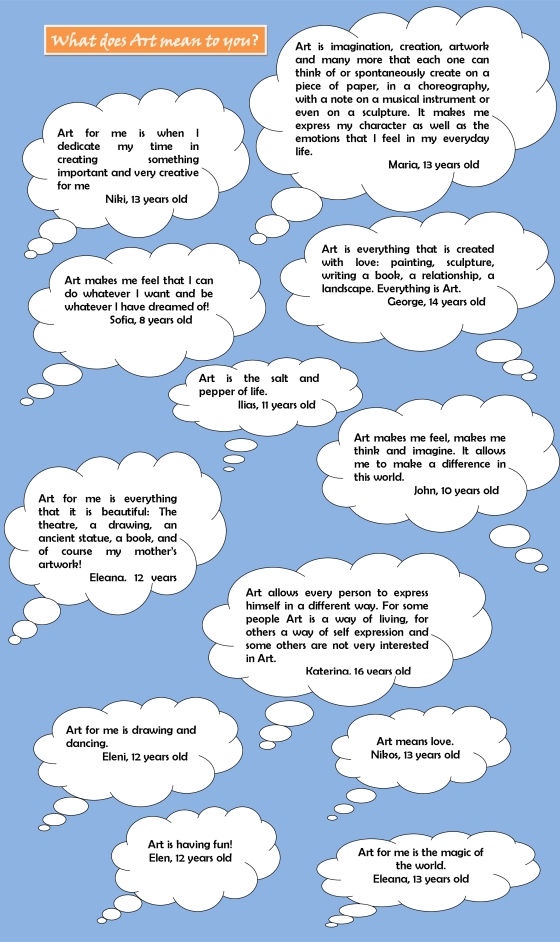
Professor of Art and Education at the Stanford Graduate School of Education
Art helps the child capture the world through every Form, Figure, Image or Movement. The child who creates, feels the excitement of the freedom of expression. The child uses his imagination, his knowledge and skills to creat a piece of art and this action stimulates the brain growth. Art engages children’s senses in open-ended play and helps them develop their Cognitive, Social, Emotional and Sensori-Motor skills. It cultivates creativity and makes learning fun.
Art, in any of its forms, means something different for every person. We could assume that there are as many definitions of art as the number of people on Earth! I asked my students what art means to them, and here are their answers:


Teaching art at school helps students develop sociability and overcome individualism, since it excludes the element of rejection and encourages the active participation and cooperation. Therefore, art is “freedom is a place of freedom and expression but simultaneously a meeting place with others”, (Danassis-Anefantakis, 1997, p.24). Art creates cultures and civilizations, so has a cultural offering. It provides students with useful ways to understand the past and present experiences of others, teaches them to adapt and respect the different ways of thinking and acting, to share their ideas and feelings through many ways.
Chapman (1998) categorizes these views, arguing that through art the child succeeds: a) personal fulfillment, b) appreciation of the artistic heritage, c) awareness of the social role of art. The personal fulfillment is performed by using art as a means of expression. The appreciation of the artistic heritage and culture is achieved by the contact of children with the art and in this way they learn to give value to the works of others and at the same time to appreciate theirs. The awareness of the social role of art is achieved through the figures that the child creates which help him to express himself, find his identity and realise the fact that he belongs to a particular group or culture.
So, let’s enhance our spatial and kinesthetic intelligence …or, in other words, our artistic expression through movement!
Exploring moving and marking qualities. How wonderful is it?
When you listen to music, multiple areas of your brain become engaged and active. But when you actually play an instrument, that activity becomes more like a full-body brain workout. In the following video Anita Collins explains the fireworks that go off in musicians’ brains when they play, and examines some of the long-term positive effects of this mental workout.
Sources: Chapman, L. (1993). Art Education. Approaches to artistic education [In Greek]. Athens: Nefeli
Danassis-Afentakis, A. (1997). Modern trends in treatment. [In Greek]. Athens: Gkelmpesis
Suggestions:
Villa Zebra is a unique museum and art laboratory for children, which is located in Rotterdam. Visit the website: http://www.villazebra.nl/
And for my Greek friends The Museum of Greek Children’s Art is a pioneering Museum, one of the very few worldwide that exhibits exclusively drawings and three-dimensional artworks created by children 5 to 14 years old http://www.childrensartmuseum.gr/.
“Every child is an artist. The problem is how to remain an artist once he grows up“. ~Pablo Picasso, quoted in Time, October 1976.
(Quotations about Art: http://www.quotegarden.com/art.html)
Many thanks to my lovely students for their answers!

Pingback: Learning Through Art | Anastasia Kalokyri
Very interesting and useful site! It really catches the attention and provides scientific material as well as inspiration and good ideas! Please continue with new subjects …
LikeLike